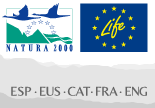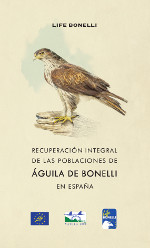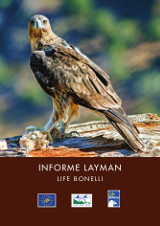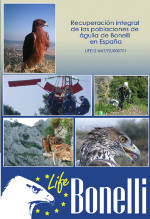
No end to the electrocution of Bonelli’s Eagles: this time it happened to 'Álora'
As in previous occasions (sadly too many), we regret to inform you about the loss of another animal we had been monitori...
First egg of a Bonelli’s Eagle in 2016
Our captivity breeding team observed attentively the cameras, but finally the female Bonelli’s Eagle chose to lay her fi...
At your disposition the Virtual Library of the Bonelli’s Eagle
In the Virtual Library of the Bonelli’s Eagle we offer you around 300 documents related to the Bonelli’s Eagle, its cons...
Life Bonelli: Improvement measures of habitat in Navarra
As part of the Life Bonelli Project, several improvement measures of the habitat of Bonelli’s Eagles are planned. During...
- Details
- Created: 17 April 2015
- Hits: 1965
Authors: C.Fernandez and P. Azkona (2014)
The Bonelli Eagle in Álava-Araba:
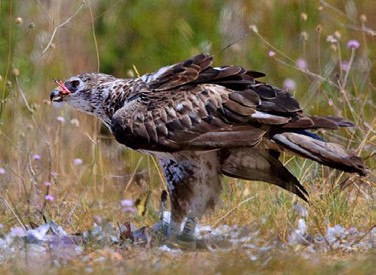 The Bonelli Eagle (Aquila fasciata) is a species included in Annex I of the Birds Directive (79/409/CEE), considered “Vulnerable” in Spain (Real Decreto 439/90) and catalogued as “endangered” in the Autonomous Community of the Basque Country (Orden 87/7/1997).
The Bonelli Eagle (Aquila fasciata) is a species included in Annex I of the Birds Directive (79/409/CEE), considered “Vulnerable” in Spain (Real Decreto 439/90) and catalogued as “endangered” in the Autonomous Community of the Basque Country (Orden 87/7/1997).
Its demographic situation in the region is extremely serious with just one reproductive couple within the historic territory of Alava-Araba, a noticeable recession in the region (3 reproductive couples have disappeared in the last 20 years) and a high number of handicaps around the nesting areas (overhead wires, persecution, infrastructure works, human trouble, etc.) (Illana et al. 1997, Fernández y Azkona 2000, Del Moral 2006).
Both the Management Plan for the Bonelli Eagle in Alava-Araba (Orden Foral 612/2001) and Action C5 of the LIFE-Bonelli Project (LIFE12NAT/ES/0701) foresee, amongst others, the necessity of a continuous monitoring and control of the population in Alava-Araba, aiming to have updated information on the reproductive parameters and the evolution of the population.
This memory summarises the actions to control the reproductive population and the floating population to determine the mortality and reposition rates of adults and to know the situation of abandoned territories, the outcome of “Garnatxa” the radio-monitoring via satellite during its stay in Álava and the observing of floating population specimens, including the locations of the specimens that have been monitored within the LIFE Bonelli Project. (LIFE12NAT/ES/0701).
POPULATION CONTROL AND MONITORING OF THE REPRODUCTION:
Surveillance, monitoring and control of the population:
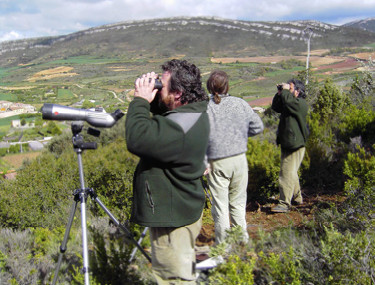 Population control and exhaustive monitoring of the reproduction of the couple established in Álava (Sierra de Toloño), has taken place during 2014 as well as the inspection of the old territories occupied by the species.
Population control and exhaustive monitoring of the reproduction of the couple established in Álava (Sierra de Toloño), has taken place during 2014 as well as the inspection of the old territories occupied by the species.
The Environment Rangers of the Diputación Foral de Alava-Araba have participated in the control and monitoring works and we must mention the monitoring of the reproductive couple in Sierra de Toloño performed by Andoni Díaz (Environment Ranger of the Natural Parks in Alava-Araba).
The exact dates for the visit were established in advance within a specific work agenda and a four-month calendar, in order to have reliable information, to do a continuous monitoring based on a homogeneous research and to facilitate the monitoring job.
The Environment Rangers and also the Rangers of the Natural Parks of the Diputación Foral de Alava-Araba, have devoted 28 field work days to controlling the reproduction and surveying the breeding area in Toloño and the abandoned territories. These controls have been interspersed and complemented with 26 control work days of study, carried out by the external technical consultants. As a whole, more than 54 field work days have been devoted to monitoring the species.
Controlling the couple in Sierra de Toloño:
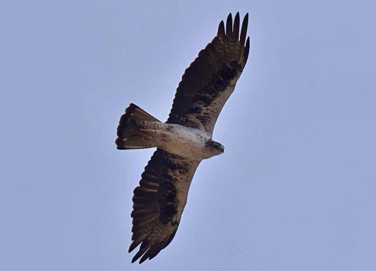 After the death of the reproductive female of the couple in Toloño (“Estitxu”) in April 2013, the territorial male (“Thor”) has remained widowed during the season, sharing the territory with other adult specimens.
After the death of the reproductive female of the couple in Toloño (“Estitxu”) in April 2013, the territorial male (“Thor”) has remained widowed during the season, sharing the territory with other adult specimens.
Thor was equipped with a transmitter in 2006. The PPT remains inactive and still keeps the MMA metal ring, but he lost the long-distance reading ring. The male, who can be recognized while flying because of the backpack, remained within the territory throughout the season. Since the summer of 2013 until March 2014, Thor has been accompanied by an unmarked adult female; then, during March and April he was accompanied by Garnatxa (the adult female radio-monitored, from the River Ebro, La Rioja-Navarra) and from April onwards, he was alone again.
Surprisingly, since mid-march, the territorial female from the River Ebro in La Rioja-Navarra (Garnatxa), who failed incubating, settled in the Toloño territory, displacing the female who was still there (8/3/14). Since her arrival on March 14 2014 and during the 36 days she stayed in Toloño, she behaved as the territory’s owner: she wouldn’t leave Thor, flying and using the same perching places, hunting together and mating 4 times, etc. During Garnatxa’s stay in Toloño, two other couples were seen in the territory but they were expelled from the nesting area by Thor. Same as Garnatxa arrived, she left, returning on April 16, 2014 to her territory in La Rioja, where “Graciano” had shared the territory, first with a female adult and after that with an immature one. On April 18 and April 19 2014 Garnatxa made a few flights back and forth between her breeding territory and Sierra de Toloño, but from April 20, she definitively stayed within the Rio Ebro territory (La Rioja).
Mortality and reposition rates:
Adding up the results obtained this season to those gathered trough a similar methodology during the last 18 year, we confirm that the mortality rate of the reproductive population is 10.9% per year (n=46), widely exceeding the reposition rate (6.5%), due to de disappearance of the couple in Sobrón in 2001 and the death of Esitxu, with no reposition in 2013. The mortality rate in Álava (10.9% per year, n=46) is slightly lower than the one in Navarra (12.0%, n=100) and slightly higher than that of La Rioja (7.5%, n=214), which means and average age of 12-13 years.
Productivity and flying rates:
The presence in 2014 of the widowed male of the only settled couple of Bonelli Eagle and the resulting absence of reproduction, involves the maintenance of the reproductive parameters already known in Álava. Therefore, 10 out of 21 controlled reproductions between 1992 and 2014 have been successful, with an outcome of 15 chicks, which means a nesting Proportion of 48% (n=21), a flying Rate of 1.50 chicks/successful nesting (n=10), a reproductive Success of 0.83 chicks per initiated reproduction (n=18) and an average Productivity of 0.71 controlled chicks/couple (n=21).
The reproduction failure of the couple in Toloño in 2013, meant a slight fall of successful nesting proportion (from 50 to 48%), while productivity was also reduced (from 0.75 to 0.71 chicks/couple); a dangerous tendency being noticed for the last years in all the populations of the High Valley of the Ebro. On the other hand, since there was no lay in 2013 and in 2014 there wasn’t any couple for reproduction, the reproductive success remains the same (0.83 chicks/initiated reproduction) and the flying rate known for our region (1.50 chicks/successful nesting).
Reproductive phenology:
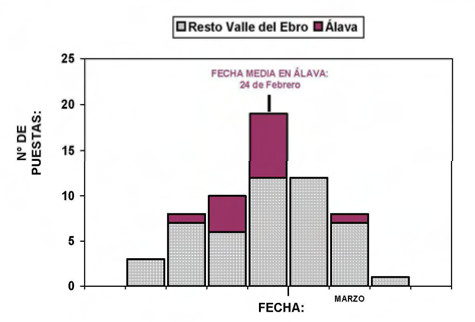 The last two seasons the couple in Sierra de Toloño has not laid eggs, and therefore the average date of lay remains the same as 2012 in Alava-Araba (Fernandez and Azkona 2012). Excluding the reposition lay in 2003, the average date in Alava-Araba is around February 24 (n=13), which coincides exactly with that estimated for the whole population in the High Valley of the Ebro. (February 25, n=65).
The last two seasons the couple in Sierra de Toloño has not laid eggs, and therefore the average date of lay remains the same as 2012 in Alava-Araba (Fernandez and Azkona 2012). Excluding the reposition lay in 2003, the average date in Alava-Araba is around February 24 (n=13), which coincides exactly with that estimated for the whole population in the High Valley of the Ebro. (February 25, n=65).
USE OF Garnatxa’s área in Álava:
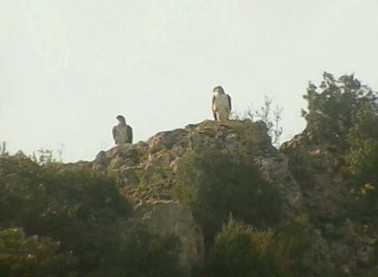 During the 36 days Garnatxa stayed in the territory of Sierra de Toloño (Alava-Araba) between March 14 2014 and April 19 2014, the PTT has given 133 positions. GPS positions received from Garnatxa in the territory of Sierra de Toloño present a lineal distribution alongside the Sierra de Gobera (burgos) and Sierra de Cabrera (Alava-Araba). Positions, especially in the night, concentrate in the nesting area of the couple (northern side of the Sierra de GObera), as well as Thor’s new sleeping spot in the southern side towards the cliff of Monasterio de Herrera.
During the 36 days Garnatxa stayed in the territory of Sierra de Toloño (Alava-Araba) between March 14 2014 and April 19 2014, the PTT has given 133 positions. GPS positions received from Garnatxa in the territory of Sierra de Toloño present a lineal distribution alongside the Sierra de Gobera (burgos) and Sierra de Cabrera (Alava-Araba). Positions, especially in the night, concentrate in the nesting area of the couple (northern side of the Sierra de GObera), as well as Thor’s new sleeping spot in the southern side towards the cliff of Monasterio de Herrera.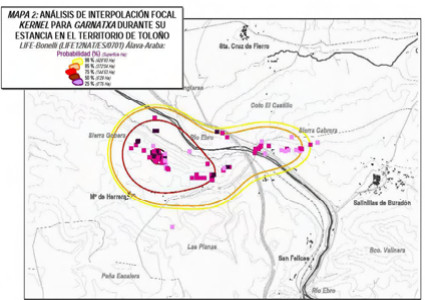 The MPC of the 133 locations gathered for Garnatxa in Alava-Araba, describes an irregular trapezium, slightly bent SW, covering an area of just 573.67 ha. The limits of the MPC are determined by Sierra de Gobera (Burgos) to the west, the groves of the River Ebro to the north, Sierra Cabrera (Alava-Araba) to the east and Las Planas en Haro (La Rioja) to the south.
The MPC of the 133 locations gathered for Garnatxa in Alava-Araba, describes an irregular trapezium, slightly bent SW, covering an area of just 573.67 ha. The limits of the MPC are determined by Sierra de Gobera (Burgos) to the west, the groves of the River Ebro to the north, Sierra Cabrera (Alava-Araba) to the east and Las Planas en Haro (La Rioja) to the south.
Garnatxa’s night locations during her stay in the territory of Toloño, concentrates even more in the Sierra de Gobera (Burgos) and particularly, in the nesting cliffs of the couple, placed at the south side of Sierra Gobera, gathering 69% of the overnight stay (n=32).
The distribution of Garnatxa’s locations in the territory of Sierra Toloño, basically coincides with those of the previous territorial female (“Estitxu”) during the last seasons, before disappearing in 2013. Nevertheless, if we compare the use of the space between Garnatxa and the previous female, we check that Garnatxa’s grazing area is more restrictive than Estitxu’s, focusing in Sierras de Gobera and Cabrera and dismissing both the coto El Castillo in Ocio (Estitxu’s main grazing area) and the passes in Haro (Estitxus’s usual sleeping spot during the last seasons she was radio-monitored) (Fernandez y Azkona 2012)
ABANDONED TERRITORIES AND FLOATING POPULATION:
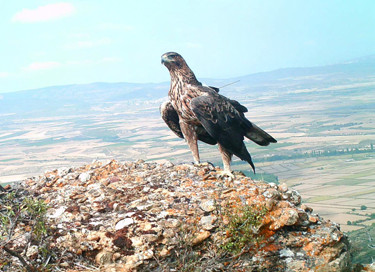 Población flotante:
Población flotante:
No specimen of Bonelli eagle has been spotted settled in the old territories of Sobron, Peñacerrada or Angostina during 2014. On the contrary, on 6 occasions non-territorial specimens have been detected in Sierra Toloño: 4 adults and 2 sub-adults.
On March 3 and April 1 2014, we saw Thor expelling two adult specimens from the territory, and on April 8, while Garnatxa was perched on the crest of Sierra Gobera, we spotted Thor fighting with two adults of Bonelli eagle at the barranco de Herrera (Burgos). After that, we saw two sub-adults (May 16 and June 18). The sub-adult spotted on May 5, at coto de Ocio didn’t coincide with Thor, while the sub-adult spotted on June 18 flying in Sierra Gobera, was pursued and expelled from the territory by the male owner.
On the other hand, the two chicks of Bonelli Eagle introduced by hacking in Navarra in 2012 ("Beragu” and “On the other hand, the two chicks of Bonelli Eagle introduced by hacking in Navarra in 2012 (Beragu” and “Helena”) have made many displacements during the last two years, visiting several areas of the historic territory of Alava-Araba.”) have made many displacements during the last two years, visiting several areas of the historic territory of Alava-Araba.
Beragu, the male, during his 160 days flying, visited during 2012, the southern cliffs of Sierra Cantabria, next to El Villar (Alava-Araba) and Alto de Toloño in 2012 in Peñacerrada (Alava-Araba).
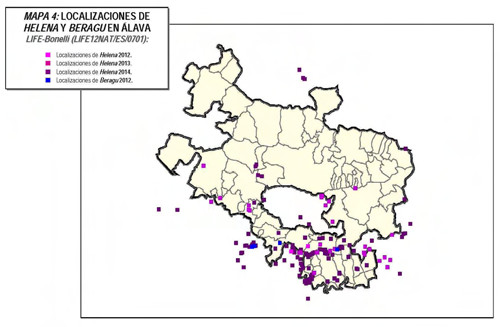 Helena, the subadult female settled in the Ribera de Navarra, has progressively increased the visits to Alava-Araba: twice spotted in 2012, 29 times in 2013 and 86 in 2014. Most of these 117 visits were distributed over the southern of Alava-Araba, concentrating most of all within Rioja Alavesa (71%) and especially in Sierra de Cantabria and Sonsierra (66%).
Helena, the subadult female settled in the Ribera de Navarra, has progressively increased the visits to Alava-Araba: twice spotted in 2012, 29 times in 2013 and 86 in 2014. Most of these 117 visits were distributed over the southern of Alava-Araba, concentrating most of all within Rioja Alavesa (71%) and especially in Sierra de Cantabria and Sonsierra (66%).
Helena has frequently visited the line of crests from east to west Rioja alavesa, from Codés to Obarenes, focusing on the cliffs in El villar, Recilla-Peña Parda, El León and Herrea (municipalities of Kripán, El Villar Laguardia, Leza and Samaniego).
Despite the repetition, Helena’s visits to Alava-Araba haven’t been visually recorded, which indicates that the flow of the floating population is more intense than thought; in this sense, the visits made by specimens which are radio-monitored by satellite are an excellent indicator of the spots preferred by the species, which is of great interest for future conservation and habitat improvement work.
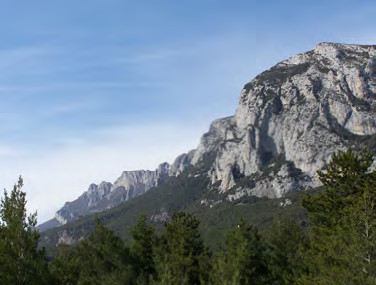
MARKING PROGRAMME ON THE HIGH EBRO VALLEY:
Following the marking protocol established for the population in the High Ebro Valley (Fernandez 2005), in 2014 we have proceed to marking 4 chicks; including 3 chicks introduced by hacking in Tafalla (Navarra) and the only chick that flied belonging to the couple in Cidacos Bajo (La Rioja). The chicks were marked with MMA metal rings and EBD-CSIC long-distance reading white rings as per the following codes: “Iñar” (10-29304/55H), “Txara” (55L/10-29306), “Filabres” (5A0/10-9305) and “Almudena” (59W/10-02366).
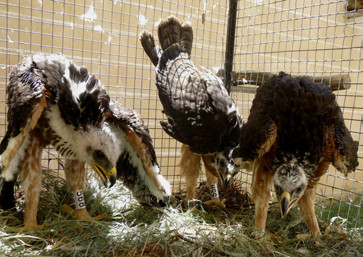 |
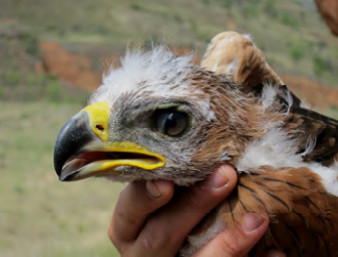 |
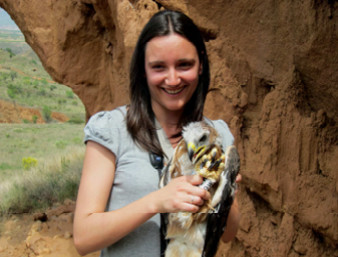 |
Up to date 31 specimens of the population in the High Ebro Valley (Álava, La Rioja and Navarra) have been marked: 5 adults and 26 fledgling chicks; 16 of them sexed male and 15 female. Two of the chicks introduced in Gallipenzo this year (“Iñar” and Txara”) died a few days after starting flying. Also, on February 2 2014 the dead body of “Beragu” (55P) was recovered in Camino de Besolla (Navarra), after 20 months flying. 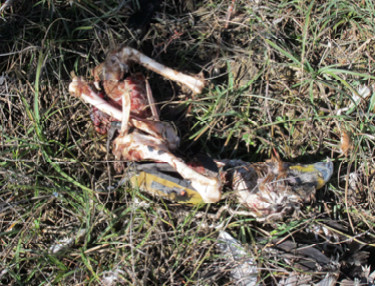
Finally on May 12 2014, we had notice of “Sandra's” death (16X), a 3 year old female that died to electrocution in Navas del Sotobral (Salamanca). On the contrary, in 2014 we have detected two specimens marked with rings: an immature female with a metal red ring (CN) dated June 7 2013 in Ginestar (Tarragona) and photographed on March 29 2014 by the River Ebro and an adult male with a PVC yellow ring (0JX) marked in Montpellier (France) and seen on February 2 2014 and April 22 2014 in Lókiz.
Besides, as we have seen, during the season 2014 we have checked the survival of 3 ringed and radio-monitored specimens: “Garnatxa” (16W), “Thor” (40T) and “Helena” (566) although the last two of them have lost their PVC rings and are only recognizable by the transmitter and because they still keep the MMA metal ring.
Fernández, C. y P. Azkona (2014).- Control de la población y seguimiento de la reproducción del Águila de Bonelli (Aquila fasciata) en Álava-Araba. Proyecto LIFE-Bonelli (LIFE12NAT/ES/0701). Servicio de Medio Ambiente y Biodiversidad, D.F. de Álava: 46 pp.
Photo News
Latest News
- 29 January 2016 No end to the electrocution of Bonelli’s Eagles: this time it happened to 'Álora'
- 22 January 2016 First egg of a Bonelli’s Eagle in 2016
- 11 January 2016 At your disposition the Virtual Library of the Bonelli’s Eagle

